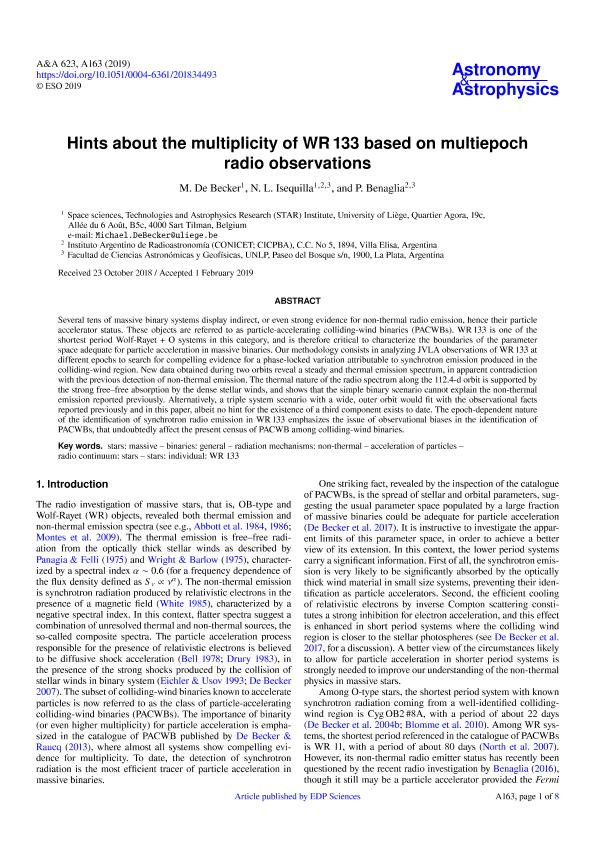Mostrar el registro sencillo del ítem
dc.contributor.author
De Becker, M.

dc.contributor.author
Isequilla, Natacha Laura

dc.contributor.author
Benaglia, Paula

dc.date.available
2020-12-30T12:31:08Z
dc.date.issued
2019-03
dc.identifier.citation
De Becker, M.; Isequilla, Natacha Laura; Benaglia, Paula; Hints about the multiplicity of WR 133 based on multiepoch radio observations; EDP Sciences; Astronomy and Astrophysics; 623; 3-2019; 163-170
dc.identifier.issn
0004-6361
dc.identifier.uri
http://hdl.handle.net/11336/121344
dc.description.abstract
Several tens of massive binary systems display indirect, or even strong evidence for non-thermal radio emission, hence their particle accelerator status. These objects are referred to as particle-accelerating colliding-wind binaries (PACWBs). WR 133 is one of the shortest period Wolf-Rayet + O systems in this category, and is therefore critical to characterize the boundaries of the parameter space adequate for particle acceleration in massive binaries. Our methodology consists in analyzing JVLA observations of WR 133 at different epochs to search for compelling evidence for a phase-locked variation attributable to synchrotron emission produced in the colliding-wind region. New data obtained during two orbits reveal a steady and thermal emission spectrum, in apparent contradiction with the previous detection of non-thermal emission. The thermal nature of the radio spectrum along the 112.4-d orbit is supported by the strong free-free absorption by the dense stellar winds, and shows that the simple binary scenario cannot explain the non-thermal emission reported previously. Alternatively, a triple system scenario with a wide, outer orbit would fit with the observational facts reported previously and in this paper, albeit no hint for the existence of a third component exists to date. The epoch-dependent nature of the identification of synchrotron radio emission in WR 133 emphasizes the issue of observational biases in the identification of PACWBs, that undoubtedly affect the present census of PACWB among colliding-wind binaries.
dc.format
application/pdf
dc.language.iso
eng
dc.publisher
EDP Sciences

dc.rights
info:eu-repo/semantics/openAccess
dc.rights.uri
https://creativecommons.org/licenses/by-nc-sa/2.5/ar/
dc.subject
STARS: MASSIVE
dc.subject
BINARIES: GENERAL
dc.subject
RADIATION MECHANISMS: NON-THERMAL
dc.subject
ACCELERATION OF PARTICLES
dc.subject.classification
Astronomía

dc.subject.classification
Ciencias Físicas

dc.subject.classification
CIENCIAS NATURALES Y EXACTAS

dc.title
Hints about the multiplicity of WR 133 based on multiepoch radio observations
dc.type
info:eu-repo/semantics/article
dc.type
info:ar-repo/semantics/artículo
dc.type
info:eu-repo/semantics/publishedVersion
dc.date.updated
2020-11-11T15:51:59Z
dc.journal.volume
623
dc.journal.pagination
163-170
dc.journal.pais
Francia

dc.journal.ciudad
Paris
dc.description.fil
Fil: De Becker, M.. Université de Liège; Bélgica
dc.description.fil
Fil: Isequilla, Natacha Laura. Universidad Nacional de La Plata. Facultad de Ciencias Astronómicas y Geofísicas; Argentina
dc.description.fil
Fil: Benaglia, Paula. Provincia de Buenos Aires. Gobernación. Comisión de Investigaciones Científicas. Instituto Argentino de Radioastronomía. Consejo Nacional de Investigaciones Científicas y Técnicas. Centro Científico Tecnológico Conicet - La Plata. Instituto Argentino de Radioastronomía; Argentina
dc.journal.title
Astronomy and Astrophysics

dc.relation.alternativeid
info:eu-repo/semantics/altIdentifier/url/https://www.aanda.org/10.1051/0004-6361/201834493
dc.relation.alternativeid
info:eu-repo/semantics/altIdentifier/doi/http://dx.doi.org/10.1051/0004-6361/201834493
Archivos asociados
